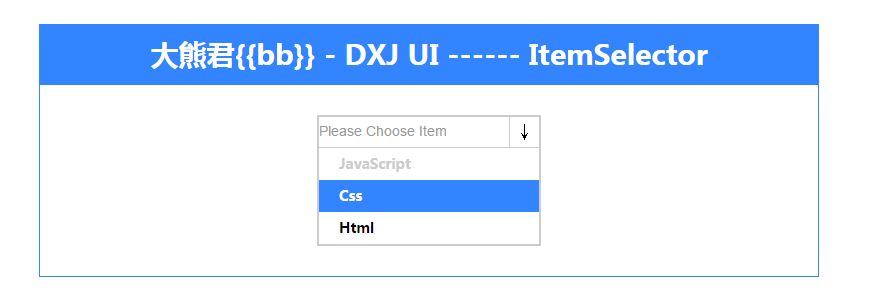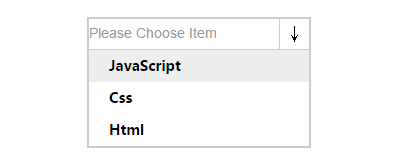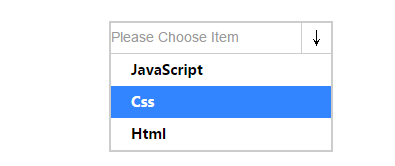一,開頭分析
今天這篇文章我們說點什麼那?嘿嘿嘿。我們接著上篇文章對不足的地方進行重構,以深入淺出的方式來逐步分析,讓大家有一個循序漸進提高的過程。廢話少說,進入正題。讓我們先來回顧一下之前的
Js部分的程式碼,如下:
function ItemSelector(elem,opts){
this.elem = elem ;
this.opts = opts ;
} ;
var ISProto = ItemSelector.prototype ;
ISProto.getElem = function(){
return this.elem ;
} ;
ISProto.getOpts = function(){
return this.opts ;
} ;
/* data manip*/
ISProto._setCurrent = function(current){
this.getOpts()["current"] = current ;
} ;
ISProto.getCurrentValue = function(current){
return this.getOpts()["current"] ;
} ;
/* data manip*/
ISProto.init = function(){
var that = this ;
this.getOpts()["current"] = null ; // 資料遊標
this._setItemValue(this.getOpts()["currentText"]) ;
var itemsElem = that.getElem().find(".content .items") ;
this.getElem().find(".title div").on("click",function(){
itemsElem.toggle() ;
}) ;
this.getElem().find(".title span").on("click",function(){
itemsElem.toggle() ;
}) ;
$.each(this.getOpts()["items"],function(i,item){
item["id"] = (new Date().getTime()).toString() ;
that._render(item) ;
}) ;
} ;
ISProto._setItemValue = function(value){
this.getElem().find(".title div").text(value)
} ;
ISProto._render = function(item){
var that = this ;
var itemElem = $("
")
.text(item["text"])
.attr("id",item["id"]) ;
if("0" == item["disabled"]){
itemElem.on("click",function(){
var onChange = that.getOpts()["change"] ;
that.getElem().find(".content .items").hide() ;
that._setItemValue(item["text"]) ;
that._setCurrent(item) ;
onChange && onChange(item) ;
})
.mouseover(function(){
$(this).addClass("item-hover") ;
})
.mouseout(function(){
$(this).removeClass("item-hover") ;
}) ;
}
else{
itemElem.css("color","#ccc").on("click",function(){
that.getElem().find(".content .items").hide() ;
that._setItemValue(item["text"]) ;
}) ;
}
itemElem.appendTo(this.getElem().find(".content .items")) ;
} ;
效果如下圖:

a)------非可操作狀態

b)------可操作狀態

(二),打開思路,進行重構
大家從程式碼不難看出,已經透過「Js」中的語法特性,以物件導向的方式進行了有效的組織,比鬆散的過程化形式的組織方式好多了,但是仍然會發現有很多不足的地方。
(1),裡面重複程式碼太多
(2),職責劃分不清晰
(3),流程梳理不健全
我們基於以上幾點進行有效的重構,我們首先要梳理一下這個組件的需求,功能點如下:
(1),初始化設定元件
$(function(){
var itemSelector = new ItemSelector($("#item-selector"),{
currentText : "Please Choose Item" ,
items : [
{
text : "JavaScript" ,
value : "js" ,
disabled : "1"
} ,
{
text : "Css" ,
value : "css" ,
disabled : "0"
} ,
{
text : "Html" ,
value : "html" ,
disabled : "0"
}
] ,
}) ;
itemSelector.init() ;
}) ;
這塊程式碼很清晰,不需要做任何修改,但是大家可以基於以上配置擴充功能,例如增加設定項「mode」支援多種選項方式。如:「checkbox勾選模式」。
接下來是要完成初始化邏輯,如下:
ISProto.init = function(){
var that = this ;
this.getOpts()["current"] = null ; // 資料遊標
this._setItemValue(this.getOpts()["currentText"]) ;
var itemsElem = that.getElem().find(".content .items") ;
this.getElem().find(".title div").on("click",function(){
itemsElem.toggle() ;
}) ;
this.getElem().find(".title span").on("click",function(){
itemsElem.toggle() ;
}) ;
$.each(this.getOpts()["items"],function(i,item){
item["id"] = (new Date().getTime()).toString() ;
that._render(item) ;
}) ;
} ;
這段程式碼問題很多,職責不明確,初始化邏輯包含了功能點的細節實作。
再繼續看渲染部分程式碼:
ISProto._render = function(item){
var that = this ;
var itemElem = $("
")
.text(item["text"])
.attr("id",item["id"]) ;
if("0" == item["disabled"]){
itemElem.on("click",function(){
var onChange = that.getOpts()["change"] ;
that.getElem().find(".content .items").hide() ;
that._setItemValue(item["text"]) ;
that._setCurrent(item) ;
onChange && onChange(item) ;
})
.mouseover(function(){
$(this).addClass("item-hover") ;
})
.mouseout(function(){
$(this).removeClass("item-hover") ;
}) ;
}
else{
itemElem.css("color","#ccc").on("click",function(){
that.getElem().find(".content .items").hide() ;
that._setItemValue(item["text"]) ;
}) ;
}
itemElem.appendTo(this.getElem().find(".content .items")) ;
} ;
問題很明顯,發現了重複性的操作,應該進行合理的抽象,已達到復用的目的。
整個組成的流程包括初始化,渲染(事件綁定),還有就是相關的資料操作方法以及dom操作的輔助方法。
綜上所述,經過簡單的梳理後,我們應該建立起功能的操作目的以及流程主線的任務分配,各負其責。
所以我們重構的目的很明確了,對!就是進行功能點的抽象,友善的職責劃分,那我們要如何實現那?
第一步,建立流程功能方法:(方法介面)
ISProto.init = function(){
// put you code here !
} ;
ISProto._render = function(){
// put you code here !
} ;
第二部,建立抽象後的方法介面:
ISProto._fnItemSelectorDelegateHandler = function(){
// put you code here !
} ;
ISProto._fnTriggerHandler = function(){
// put you code here !
} ;
ISProto._addOrRemoveClass = function(){
// put you code here !
} ;
第三步,建立資料操作介面:
ISProto._setCurrent = function(){
// put you code here !
} ;
ISProto._getCurrent = function(){
// put you code here !
} ;
還有一些參考下面的完整源碼,這裡只是說的思路。
(三),完整程式碼以供學習,本程式碼經過測試
function ItemSelector(elem,opts){
this.elem = elem ;
this.opts = opts ;
this.current = -1 ; // 資料遊標
} ;
var ISProto = ItemSelector.prototype ;
/* getter api*/
ISProto.getElem = function(){
return this.elem ;
} ;
ISProto.getOpts = function(){
return this.opts ;
} ;
ISProto._getCurrent = function(){
return this.current ;
} ;
/* getter api*/
/* data manip*/
ISProto._setCurrent = function(current){
this.current = current ;
} ;
ISProto._setItemText = function(text){
this.getElem().find(".title div").text(text) ;
} ;
/* data manip*/
/* update on 2015 1/31 23:38 */
ISProto._fnTriggerHandler = function(index,text,value){
if(this._isDisabled(value)){
index = -1 ;
text = this.getOpts()["currentText"] ;
}
this._setItemText(text) ;
this._setCurrent(index) ;
this.getElem().find(".content .items").hide() ;
} ;
ISProto._addOrRemoveClass = function(elem,className,addIs){
if(addIs){
elem.addClass(className) ;
}
else{
elem.removeClass(className) ;
}
} ;
ISProto._fnItemSelectorDelegateHandler = function(){
var that = this ;
this.getElem().on("click","[data-toggle]",function(){
that.getElem().find(".content .items").toggle() ;
}) ;
} ;
ISProto._isDisabled = function(value){
return ("1" == value) ? true : false ;
} ;
/* update on 2015 1/31 23:38 */
ISProto.init = function(){
var that = this ;
this._fnItemSelectorDelegateHandler() ;
$.each(this.getOpts()["items"],function(i,item){
item["index"] = i ;
that._render(item) ;
}) ;
this._fnTriggerHandler(this._getCurrent(),this.getOpts()["currentText"],"1") ;
} ;
ISProto._render = function(item){
var that = this ;
var itemElem = $("
").text(item["text"]).attr("id",item["index"]) ;
var activeClass = ("0" == item["disabled"]) ? "item-hover" : "item-disabled-hover" ;
itemElem.on("click",function(){
that._fnTriggerHandler(item["index"],item["text"],item["disabled"]) ;
})
.mouseover(function(){
that._addOrRemoveClass($(this),activeClass,true) ;
})
.mouseout(function(){
that._addOrRemoveClass($(this),activeClass,false) ;
}) ;
itemElem.appendTo(this.getElem().find(".content .items")) ;
} ;
(四),最後總結
(1),物件導向的思考方式合理分析功能需求。
(2),以類別的方式來組織我們的插件邏輯。
(3),不斷重構上面的實例,如何進行合理的重構那?不要設計過度,要游刃有餘,推薦的方式是過程化設計與物件導向思想設計結合。
(4),下篇文章中會擴充相關功能,例如「mode」這個屬性,為"1"時支援checkbox多選模式,現在只是預設下拉模式。
看我本文,是不是要比上一篇程式碼優秀了很多呢,小夥伴們自己做專案也應該多想多做,盡量使自己的程式碼更加的合理。







